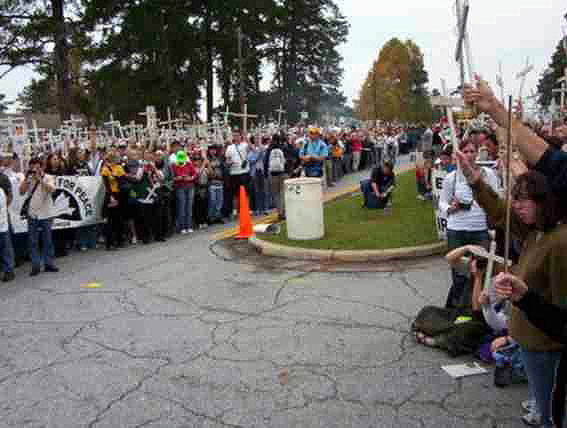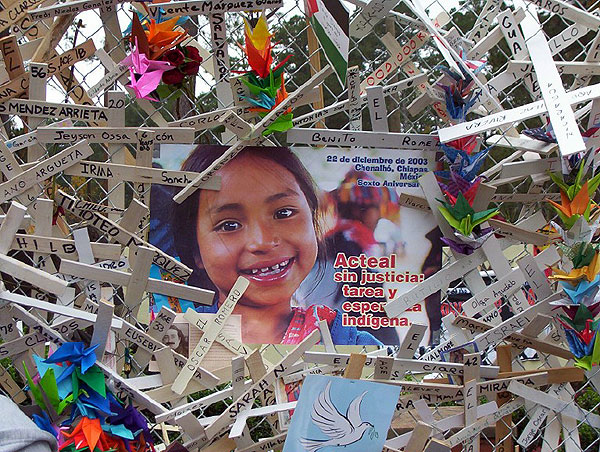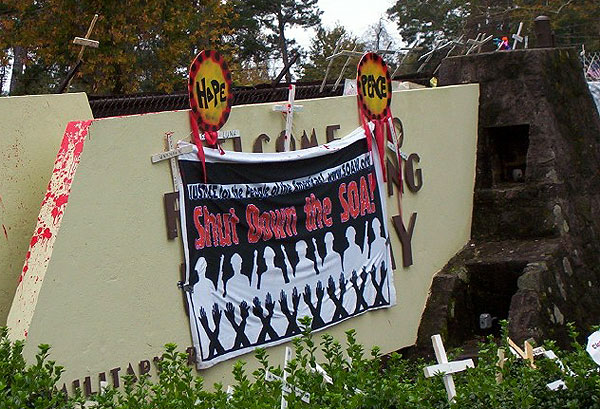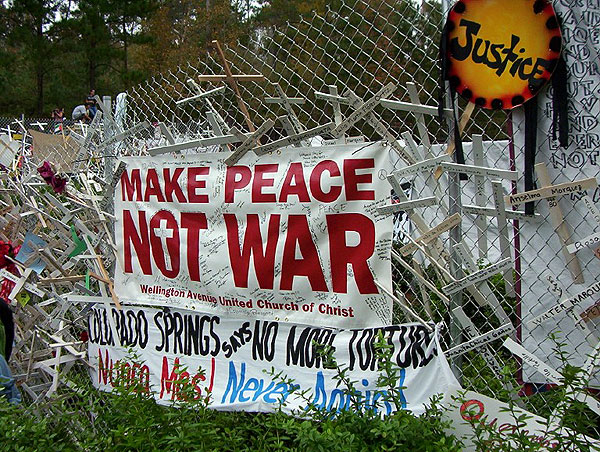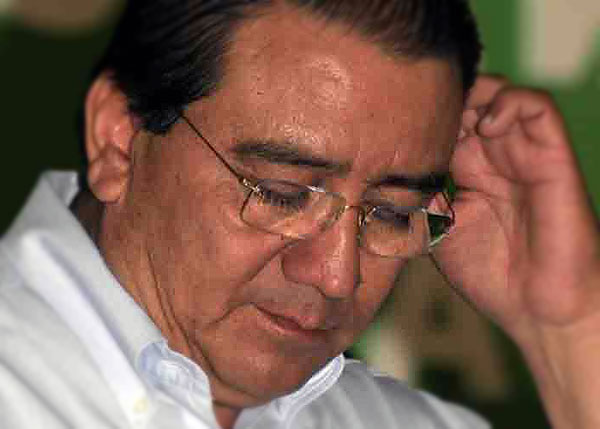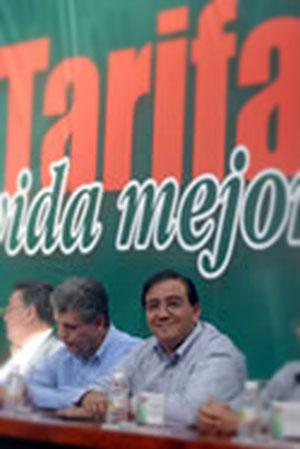SIPAZ Activities (July – September, 2004)
30/09/20042004
31/12/2004
Sunday, November 21st: The day begins cloudy and the street slowly starts to fill with people who gather in front of the entrance to the military base at Fort Benning in Columbus, Georgia, USA. Within a few hours we are around 16,000 strong. Everyone carries a white cross. On each cross is written the name of a Latin American person, with their age and the date of their death. In my hands, I carry a white cross with the name Lorenzo Gómez Perez, victim of the massacre at Acteal, on December 22nd, in Chiapas. The march begins at 10 am, moving slowly towards the entrance to the military base. From the podium, people chant to a Gregorian melody the names of thousands of victims – children, elders, youth, men and women. The 16,000 voices respond with a cry of “¡PRESENTE!” (“present”), and for more than two hours we march slowly until all of the crosses have been placed in the chain link fence at the entrance to the base.
This is the protest that happens yearly at the School of the Americas (SOA) to denounce the existence of this institution dedicated to training soldiers throughout Latin America. These days, its name has been changed and it is now officially called The Western Hemispheric Institute for Security Cooperation (WHISC). The School was founded in Panama in 1946 by the US military to help Latin American governments promote “stability” and “democracy” in their respective countries, and was moved in 1984 to Fort Benning, Georgia, USA. However, the school soon lost credibility when it was revealed that its graduates had contributed to establishing at least 10 military dictatorships and that various graduates had participated in assassinations, massacres and human rights violations in Latin America.
One of the most extreme and well-known cases was the murder of six Jesuit priests, their assistant and her daughter in El Salvador in 1989. The UN Truth Commission determined that 19 of the 27 soldiers involved in the massacre were graduates of the School of the Americas. Unfortunately, this is just one of many similar occurrences that have happened in countries like Honduras, Guatemala and Peru.
The School manuals published in 1996 made clear that the institution taught and trained soldiers in techniques of physical and psychological torture, interrogation, counter-insurgency, low-intensity warfare, as well as in sniper and commando operations (Centro de Investigaciones Económicas y Políticas de Acción Comunitaria-CIEPAC).
During the school’s first 50 years of existence, México sent few students to the School of the Americas. But during the past decade, México’s participation has increased to the point that in 1997, one third of the school’s graduates were Mexican. At least 18 military officials with high-level appointments in Chiapas, Guerrero and Oaxaca were trained at the School of the Americas.
But this year’s protest was not only dedicated to denouncing the consequences of the school experienced in Latin America, but also the sending of thousands and thousands of US troops to the war in Iraq. The mother of a soldier who had gone missing in combat shared with us the importance of seeing every soldier killed not only as a “casualty of war” but as a person in a social context, with family, friends, a job, etc…
There were all kinds of people among the activists: nuns, punks, students, war veterans (many from the Vietnam War), journalists, and children. Every year this act of civil disobedience has consisted of “crossing the line.” Before, it meant literally crossing over a line on the ground that marked the entrance to the base, which is prohibited and therefore to cross it means being arrested. This year one had to climb over the fence that bars entrance to the base. Twenty people were arrested and will be forced to serve between 3 to 6 months in prison for entering the base and opposing the policies of their own government during an act of civil disobedience. Since 1990, when these annual protests began, 170 activists – including many nuns – have served a total of 85 years in prison for protesting the school and its policies.
For me, this protest was the final part of a three week tour of the US which I began just two days after the country’s presidential elections. It was the first time in years that I had been back to the US. Passing through immigration was a strange and terrorizing experience, not just because of the disagreeable face of the immigration official, but also because of the fingerprints and photograph they took of me. This was just the start to my trip in the self-proclaimed nation of freedom.
But most distressing was finding friends from the US who were disillusioned and saddened by the results of the election, which gave Bush another four years as president. Many of them had decided to participate and put great amounts of energy into the effort to end the pro-war policies that Bush represents. One acquaintance told me that this was the first time they had participated in electoral politics because they could not stand the idea of living 4 more years with George W. Bush as president. Others also went to Florida to work on the campaign to prevent the same fraud that influenced the past elections. In the end, they were unable to achieve the desired results.
One of the things that most surprised me was the polarization that exists within US society, and which was even more evident during the time of the elections. At the protest, there were people wearing shirts and pins that said “Protest is a Patriotic Act.” I didn’t understand what the phrase meant until a friend explained to me: “The Republicans have a monopoly on the word ‘patriotism.’ When we protest against the government they see it as though we are against our own country. For us, it is important to show that not only is our protest a democratic right but that by protesting we are exercising the democracy without which our country could not exist.”
Within this context, I heard two stories that exemplify the polarization that I noticed. An eleven year old girl expressed her opinion on the war in Iraq in class, saying: “so many people have already died, and so many more innocent people will die that it would be better if the troops would come home.” The teacher punished her by sending her to sit in the corner. A university professor told me that after giving a lecture against the Iraq war on television, he had been forced to leave his job.
After seeing this situation, which is so difficult to understand from afar, the only thing that comforted me was to meet so many people who are fighting for change within their own society. I found many different people who dedicated part of their time to organizations that work to fight against economic, social and political injustice. This fight led by US citizens against the policies of their own government is part of the global movement that is trying to bring to life the dream that another world is possible. I admire these people as I admire the 16,000 voices that traveled to Fort Benning to honor the memory of all of those who have died because of the SOA, shouting “NO MAS NO MORE…”
… … … … … …
| No mas, no more shout the hills of Salvador Echo the voices of the world we cry out No Mas No more No mas No more –we must stop the dirty wars, Compañeros compañeras we cry out, |
gritando desde las montañas de El Salvador El eco de las voces del mundo, gritemos No mas no more no mas no more – debemos parar las sucias guerras Compañeros compañeras gritemos |
… … … … … …

